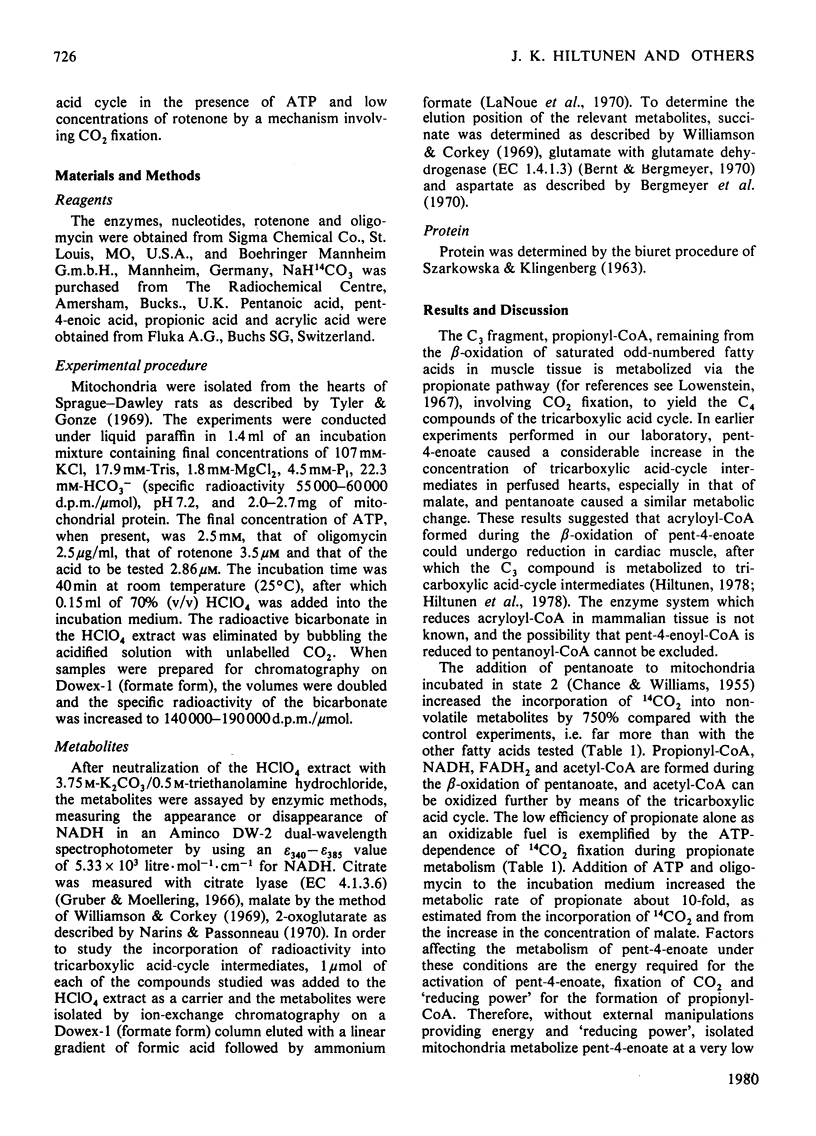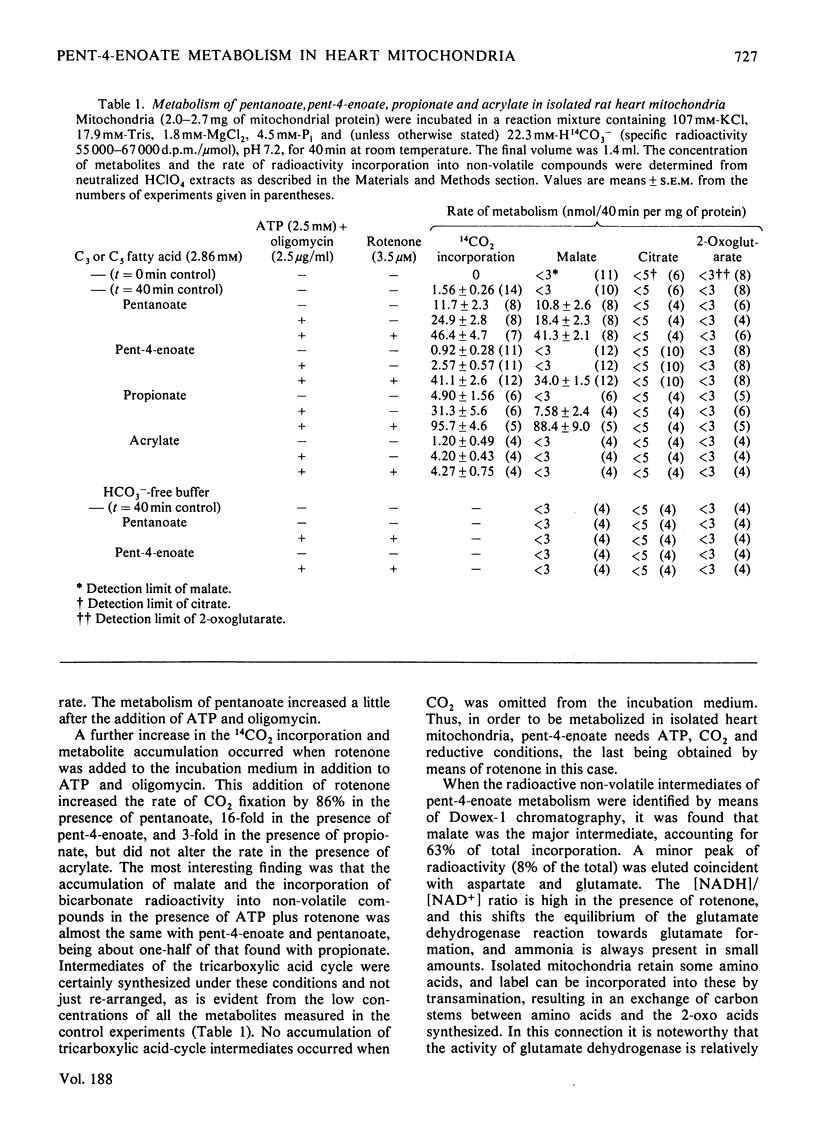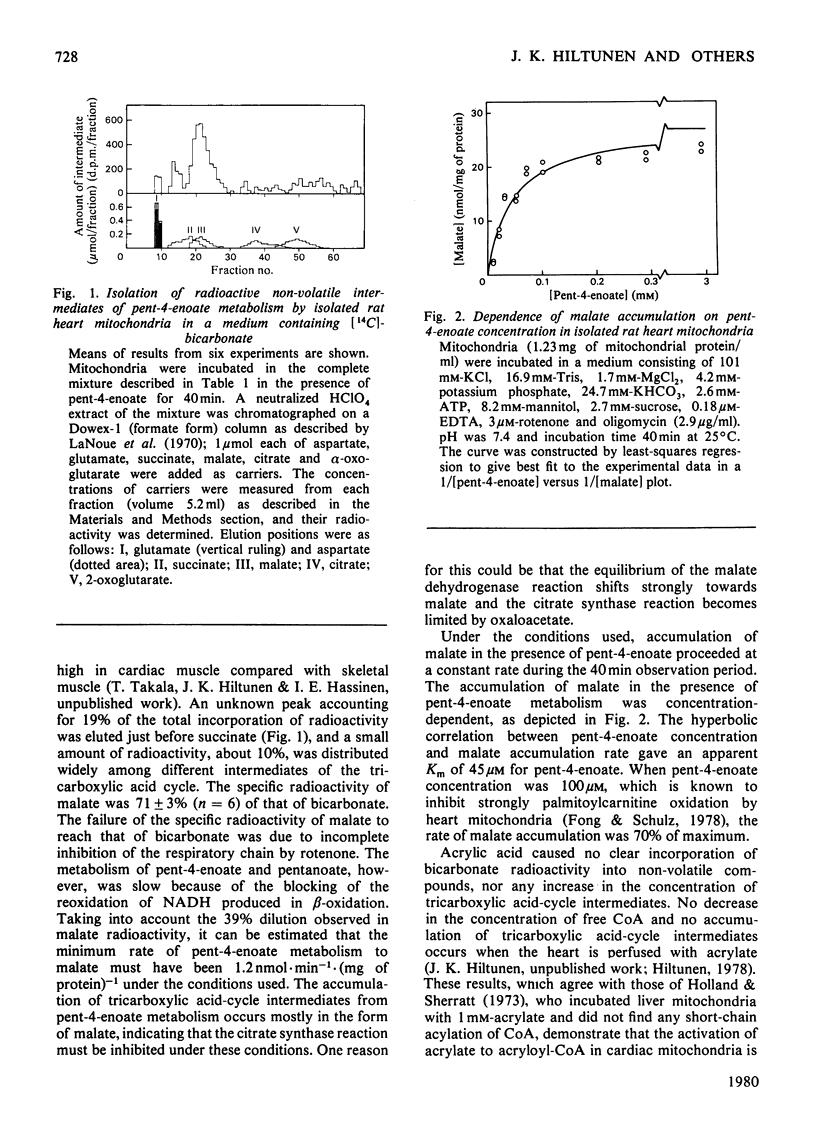Abstract
The metabolism of four short-chain odd-number-carbon fatty acids, pentanoate, pent-4-enoate, propionate and acrylate, was studied in isolated rat heart mitochondria incubated in [14C]bicarbonate buffer. Under these conditions pentanoate was metabolized with a concomitant accumulation of malate and incorporation of 14CO2 into non-volatile compounds. The metabolism of propionate to tricarboxylic acid-cycle intermediates required the addition of ATP and oligomycin. After addition of a small amount of rotenone to the incubation medium, pent-4-enoate was metabolized with an increase in malate from less than 3 nmol/mg of protein to 34.0 +/- 1.5 nmol/mg in 40 min, during which time the amount of 14CO2 fixed in acid-stable compounds increased from 1.56 +/- 0.30 to 41.1 +/- 2.6 nmol/mg of protein. Acrylate was not metabolized under any of the conditions tested. The results show that cardiac mitochondria must have an enzyme system that is capable of reducing the double bond of either pent-4-enoate or its metabolities. That the metabolism of pent-4-enoate occurs through a reductive step and energy-dependent carboxylation is evident from the requirement for NAD+ reduction by partial inhibition of the mitochondrial respiratory chain and the presence of ATP and CO2. The results do not enable us to say whether the compound reduced is pent-4-enoyl-CoA or acryloyl-CoA.
Full text
PDF




Selected References
These references are in PubMed. This may not be the complete list of references from this article.
- Billington D., Osmundsen H., Sherratt H. S. Mechanisms of the metabolic disturbances caused by hypoglycin and by pent-4-enoic acid. In vivo studies. Biochem Pharmacol. 1978;27(24):2891–2900. doi: 10.1016/0006-2952(78)90205-8. [DOI] [PubMed] [Google Scholar]
- Brendel K., Corredor C. F., Bressler R. The effect of 4-pentenoic acid on fatty acid oxidation. Biochem Biophys Res Commun. 1969 Feb 7;34(3):340–347. doi: 10.1016/0006-291x(69)90838-9. [DOI] [PubMed] [Google Scholar]
- Brown-Woodman P. D., Mohri H., Mohri T., Suter D., White I. G. Mode of action of alpha-chlorohydrin as a male anti-fertility agent. Inhibition of the metabolism of ram spermatozoa by alpha-chlorohydrin and location of block in glycolysis. Biochem J. 1978 Jan 15;170(1):23–37. doi: 10.1042/bj1700023. [DOI] [PMC free article] [PubMed] [Google Scholar]
- CHANCE B., WILLIAMS G. R. Respiratory enzymes in oxidative phosphorylation. I. Kinetics of oxygen utilization. J Biol Chem. 1955 Nov;217(1):383–393. [PubMed] [Google Scholar]
- Corredor C., Brendel K., Bressler R. Studies of the mechanism of the hypoglycemic action of 4-pentenoic acid. Proc Natl Acad Sci U S A. 1967 Dec;58(6):2299–2306. doi: 10.1073/pnas.58.6.2299. [DOI] [PMC free article] [PubMed] [Google Scholar]
- Fong J. C., Schulz H. On the rate-determining step of fatty acid oxidation in heart. Inhibition of fatty acid oxidation by 4-pentenoic acid. J Biol Chem. 1978 Oct 10;253(19):6917–6922. [PubMed] [Google Scholar]
- Fukami M. H., Williamson J. R. On the mechanism of inhibition of fatty acid oxidation by 4-pentenoic acid in rat liver mitochondria. J Biol Chem. 1971 Mar 10;246(5):1206–1212. [PubMed] [Google Scholar]
- Glasgow A. M., Chase H. P. Production of the features of Reye's syndrome in rats with 4-pentenoic acid. Pediatr Res. 1975 Mar;9(3):133–138. doi: 10.1203/00006450-197503000-00005. [DOI] [PubMed] [Google Scholar]
- Hiltunen J. K. Metabolic effects of pent-4-enoate in isolated perfused rat heart. Biochem J. 1978 Feb 15;170(2):241–247. doi: 10.1042/bj1700241. [DOI] [PMC free article] [PubMed] [Google Scholar]
- Holland P. C., Senior A. E., Sherratt H. S. Biochemical effects of the hypoglycaemic compound pent-4-enoic acid and related non-hypoglycaemic fatty acids. Effects of their coenzyme A esters on enzymes of fatty acid oxidation. Biochem J. 1973 Sep;136(1):173–184. doi: 10.1042/bj1360173. [DOI] [PMC free article] [PubMed] [Google Scholar]
- Holland P. C., Sherratt H. S. Biochemical effects of the hypoglycaemic compound pent-4-enoic acid and related non-hypoglycaemic fatty acids. Effects of the free acids and their carnitine esters on coenzyme A-dependent oxidations in rat liver mitochondria. Biochem J. 1973 Sep;136(1):157–171. doi: 10.1042/bj1360157. [DOI] [PMC free article] [PubMed] [Google Scholar]
- LaNoue K., Nicklas W. J., Williamson J. R. Control of citric acid cycle activity in rat heart mitochondria. J Biol Chem. 1970 Jan 10;245(1):102–111. [PubMed] [Google Scholar]
- Osmundsen H., Sherratt H. S. Inhibitors of beta-oxidation. Biochem Soc Trans. 1978;6(1):84–88. doi: 10.1042/bst0060084. [DOI] [PubMed] [Google Scholar]
- Osmundsen H., Sherratt H. S. The effects of pent-4-enoate and methylenecyclopropylacetate on some enzymes of beta-oxidation in extracts of liver mitochondria. Biochem Soc Trans. 1975;3(2):330–331. doi: 10.1042/bst0030330. [DOI] [PubMed] [Google Scholar]
- SZARKOWSKA L., KLINGENBERG M. ON THE ROLE OF UBIQUINONE IN MITOCHONDRIA. SPECTROPHOTOMETRIC AND CHEMICAL MEASUREMENTS OF ITS REDOX REACTIONS. Biochem Z. 1963;338:674–697. [PubMed] [Google Scholar]
- Senior A. E., Robson B., Sherratt H. S. Biochemical effects of the hypoglycaemic compound pent--4-enoic acid and related non-hypoglycaemic fatty acids. Biochem J. 1968 Dec;110(3):511–519. doi: 10.1042/bj1100511. [DOI] [PMC free article] [PubMed] [Google Scholar]
- Stanley H., Sherratt A., Osmundsen H. On the mechanisms of some pharmacological actions of the hypoglycaemic toxins hypoglycin and pent-4-enoic acid. A way out of the present confusion. Biochem Pharmacol. 1976 Apr 1;25(7):743–750. doi: 10.1016/0006-2952(76)90139-8. [DOI] [PubMed] [Google Scholar]
- Williamson J. R., Fukami M. H., Peterson M. J., Rostand S. G., Scholz R. Effect of 4-pentenoic acid on coenzyme A metabolites in rat liver. Biochem Biophys Res Commun. 1969 Aug 7;36(3):407–413. doi: 10.1016/0006-291x(69)90579-8. [DOI] [PubMed] [Google Scholar]
- Williamson J. R., Rostand S. G., Peterson M. J. Control factors affecting gluconeogenesis in perfused rat liver. Effects of 4-pentenoic acid. J Biol Chem. 1970 Jun;245(12):3242–3251. [PubMed] [Google Scholar]


